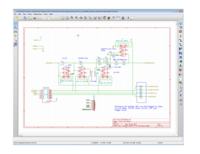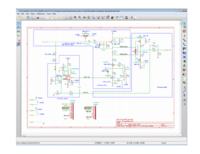stephr1
Newbie level 4
- Joined
- Dec 12, 2009
- Messages
- 5
- Helped
- 0
- Reputation
- 0
- Reaction score
- 0
- Trophy points
- 1,281
- Location
- Bay Area, CA
- Activity points
- 1,372
Hi all,
I can't remember if I've actually posted here before, but know I have visited a few times looking for help.
Here's an interesting problem I've run into. Hope someone has some good analog insight (my primary expertise is in digital).
I have built a front end amp that's supposed to go to 200MHz (I only need it for 100Mhz). The amp seems to work (it's a borrowed design...did I mention I'm a digital kind of person? for the most part (Been using an older, good condition HP 183 w/200MHz 4-Ch vert. amp).
for the most part (Been using an older, good condition HP 183 w/200MHz 4-Ch vert. amp).
While the amp has some front-end switching options (x1/x10, low-pass filter, AC/DC, etc.) implemented thru relays, I have not yet installed those parts.
Here's what I've got: Using the cal output on the scope (2KHz and 1MHz options @ .5V or 50mV), the amp and circuitry work great @ 2KHz. At 1MHz, tho, it seems a little odd. Imagine the input simply being a .01uF cap (for DC, this cap is shorted out) in series with 26.1 ohm resistor in series with a 93.1 KOhm resistor (the rest of the circuit doesn't really seem to matter with this problem).
At both 2KHz and 1MHz I can see fairly clean signals at the cap (1 side is signal in), 26.1 Ohm resistor and the side of the 93.1K that connects to the 26.1 Ohm resistor. However, when I go to the other side of of the 93.1K resistor, the 1MHz signal turns into a triangle wave (almost like the square wave is being integrated) and is much smaller in signal level.
At first I thought it might be some freq issue in the circuit after the 93.1K (goes to a 100K after which the signal is split to a 10M resistor/FET one way and ~500K resistor to an op amp input the other way). So I disconnected the 100K which left 1 side of the 93.1K open. Same results on the open end of the 93.1K resistor. Replaced the resistor (SMD) with another SMD (thinking it might be some inductance issue w/the resistor) and then tried a 1/4 watt axial. Same results.
Thought it might be the scope probe. 10M low-cap input. Same results on either of 2 probes, in any of the 4-ch of the vertical amp (BTW - Any probe/ch shows a clean 1MHz signal from the cal output).
My sense is there could be some unseen interaction with the circuit (only 3 passive components, tho) and the scope, but did I mention my background is digital.
I could sure use some help, suggestions and/or insight on this.
Thanks in advance.
Cheers...Steph
I can't remember if I've actually posted here before, but know I have visited a few times looking for help.
Here's an interesting problem I've run into. Hope someone has some good analog insight (my primary expertise is in digital).
I have built a front end amp that's supposed to go to 200MHz (I only need it for 100Mhz). The amp seems to work (it's a borrowed design...did I mention I'm a digital kind of person?
While the amp has some front-end switching options (x1/x10, low-pass filter, AC/DC, etc.) implemented thru relays, I have not yet installed those parts.
Here's what I've got: Using the cal output on the scope (2KHz and 1MHz options @ .5V or 50mV), the amp and circuitry work great @ 2KHz. At 1MHz, tho, it seems a little odd. Imagine the input simply being a .01uF cap (for DC, this cap is shorted out) in series with 26.1 ohm resistor in series with a 93.1 KOhm resistor (the rest of the circuit doesn't really seem to matter with this problem).
At both 2KHz and 1MHz I can see fairly clean signals at the cap (1 side is signal in), 26.1 Ohm resistor and the side of the 93.1K that connects to the 26.1 Ohm resistor. However, when I go to the other side of of the 93.1K resistor, the 1MHz signal turns into a triangle wave (almost like the square wave is being integrated) and is much smaller in signal level.
At first I thought it might be some freq issue in the circuit after the 93.1K (goes to a 100K after which the signal is split to a 10M resistor/FET one way and ~500K resistor to an op amp input the other way). So I disconnected the 100K which left 1 side of the 93.1K open. Same results on the open end of the 93.1K resistor. Replaced the resistor (SMD) with another SMD (thinking it might be some inductance issue w/the resistor) and then tried a 1/4 watt axial. Same results.
Thought it might be the scope probe. 10M low-cap input. Same results on either of 2 probes, in any of the 4-ch of the vertical amp (BTW - Any probe/ch shows a clean 1MHz signal from the cal output).
My sense is there could be some unseen interaction with the circuit (only 3 passive components, tho) and the scope, but did I mention my background is digital.
I could sure use some help, suggestions and/or insight on this.
Thanks in advance.
Cheers...Steph

